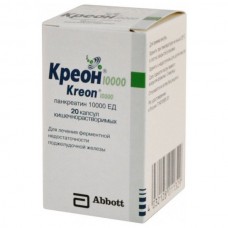Expiration date: 07/2026
The composition and form of issue:
Capsules. 1 capsule contains:
Pancreatin 150 mg
amylase 8000 IU EPH
lipase 10000 IU EPH
protease 600 IU EPH
excipients: macrogol paraffin liquid phthalate metilgidroksipropilzelluloza Dimethicone 1000 dibutyl phthalate
capsule shell: iron oxide red (E172) iron oxide black (E172) iron oxide yellow (E172) titanium dioxide (E171) gelatin
blistere in 10 PCs in the paper cartons 2 blister blistere in 25 PCs. in cardboard pack 2, or 4 blisters in polyethylene bottles of 20 and 50 PCs. in cardboard pack 1 bottle.
Description pharmaceutical form:
Two-tone hard gelatin capsule (brown opaque cap and a colourless transparent base).
The contents of the capsules: enteric-mini-microspheres beige.
Pharmacokinetics:
When the mini-microspheres reach the small intestine, enteric-soluble shell is destroyed, is released enzymes with lipolytic, amylolytic and proteolytic activity, which provide the breakdown of fats, starches and proteins.
Description pharmacological action:
The enzyme preparation that improves the process of digestion. Pancreatic enzymes included in the composition of the drug, facilitate the breakdown of proteins, fats, carbohydrates, which leads to their complete absorption in the small intestine. Capsules containing mini-microspheres coated with enteric-soluble shell to dissolve in the stomach releasing hundreds of mini-microspheres. The purpose of the principle mnogodetnoj dose is mixing mini-microspheres with intestinal contents, and, ultimately, better distribution of enzymes after their release in the intestinal content.
Indications:
replacement therapy of exocrine insufficiency of pancreatic function in cystic fibrosis, chronic pancreatitis, pancreatectomy, pancreatic cancer, obstruction of the ducts (ducts of the pancreas or common bile duct) due to neoplasms, syndrome Shwachman-diamond, in old age
symptomatic therapy of disorders of digestion in case of partial gastrectomy (Billroth-I/II), total gastroektomii after cholecystectomy, duodeno - gastrostasis, biliary obstruction, cholestatic hepatitis, liver cirrhosis, pathology of the terminal part of the small intestine, excessive bacterial growth in the small intestine.
Contraindications:
- increased individual sensitivity to product components
- acute pancreatitis
- exacerbation of chronic pancreatitis.
Application of pregnancy and breast-feeding:
Due to the lack of sufficient data on the safety of use of pancreatic enzymes in women during pregnancy and lactation the drug should be administered to pregnant women and nursing mothers only if the expected benefit to the mother outweighs the potential risk to the fetus or child.
Side effects:
Allergic reactions, rarely — diarrhea, constipation, discomfort in the stomach, nausea.
Drug interactions:
Messages about interaction with other drugs not available.
Method of application and dose:
Inside. Dose chosen individually depending on the severity of the disease and diet. It is recommended to take 1/3 or 1/2 dose in the beginning of the meal and the rest during the meal. When difficulty swallowing (e.g. young children or elderly patients) capsules cautiously opened, and the mini-microspheres added to liquid foods that do not require chewing or taken with liquid. Any mixture of mini-microspheres with food or liquid to be stored and shall be used immediately after preparation. Crushing or chewing the mini-microspheres, and adding them to foods with a pH above 5, 5 leads to the destruction of their shell, which protects it from the action of gastric juice.
In cystic fibrosis the dose depends on body weight and is at the beginning of treatment in children under 4 years of age is 1000 lipase UNITS/kg per meal over 4 years of age is 500 lipase U/kg during a meal. The dose depends on the severity of symptoms, the results of the control of steatorrhea and maintain good nutritional status. In most patients, the dose should not exceed 10000 U/kg/day.
At other States, accompanied by exocrine pancreatic insufficiency, the dose is determined taking into account the individual characteristics of the patient (deficiency of digestion, the fat content in food). Dose with main meal (Breakfast, lunch and dinner) is 20000-75000 ED EF lipase, while taking a light snack — 5000-25000 UNITS EPH lipase.
The usual initial dosage is 10000-25000 Kreon ED EF lipase with the main meal. To reduce steatorrhea and maintaining the optimal state of the patient may increase the dose. According to routine clinical practice the patient should receive with food not less than 20000-50000 UNITS EPH lipase.
Overdose:
Symptoms: hyperuricosuria, hyperuricemia.
Treatment: cancel the drug, symptomatic therapy.
Special instructions:
In patients with cystic fibrosis receiving high doses of Pancreatin preparations described stricture ileum and cecum, colitis. In the research method "case-control" was not shown evidence of the relationship with the drug Kreon and the appearance of fibrosarcoma kolonopatii. As a precaution to exclude lesions of the colon in patients with cystic fibrosis is recommended to control any unusual symptoms or changes in abdominal cavity, especially if the patient is taking more than 10,000 IU lipase/kg/day.
The drug does not affect the ability to drive the vehicle and to the control of machines and mechanisms.


